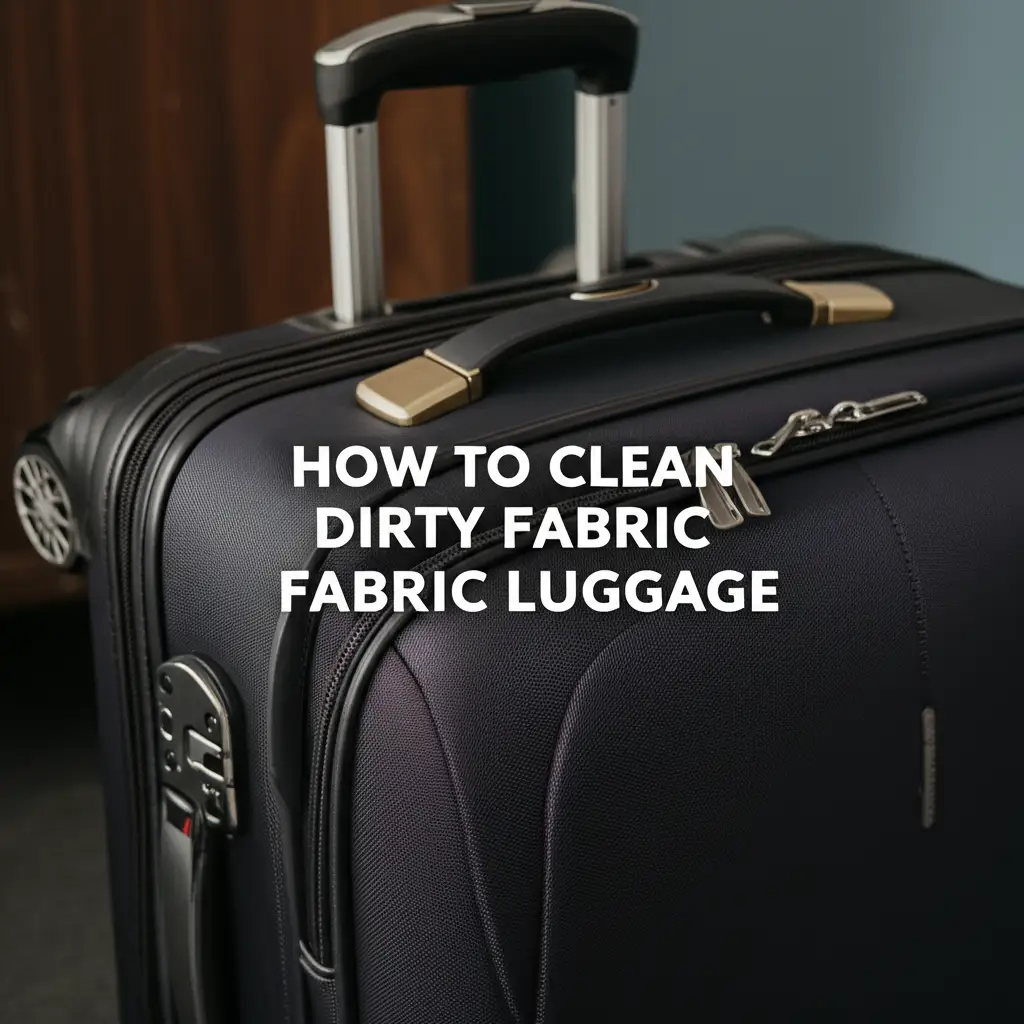· Home Cleaning · 18 min read
How To Clean Dirty Fabric Luggage

Restore Your Bags: How to Clean Dirty Fabric Luggage
Your luggage goes everywhere with you. It travels across airports, rides in car trunks, and sits on various hotel floors. Soon, your once-pristine fabric bags become dirty, stained, and even smelly. Knowing how to clean dirty fabric luggage is important for its appearance and its lifespan. This guide will walk you through easy steps to clean your fabric luggage. We cover everything from basic upkeep to deep cleaning methods. Get ready to bring your travel bags back to life!
Takeaway
Keeping your fabric luggage clean protects your investment. You can easily remove dirt and stains with simple household items. Regular cleaning prevents odors and extends the life of your bags. Always test cleaning solutions on a small, hidden area first.
To clean dirty fabric luggage, you should:
- Empty and vacuum the bag.
- Spot treat stains with mild solutions like soap and water or vinegar.
- Deep clean the entire surface gently with a soft brush.
- Rinse carefully and air dry completely to prevent mold.
- Store the luggage properly to keep it fresh.
How do you clean dirty fabric luggage?
To clean dirty fabric luggage, first empty it and vacuum all compartments. Spot treat any stains using a mild detergent and water solution or a white vinegar mix. For overall dirt, gently scrub the fabric with a soft brush or cloth dipped in a cleaning solution. Rinse carefully, avoiding oversaturation, and air dry the luggage completely in a well-ventilated area away from direct sunlight.
Why Your Fabric Luggage Gets Dirty (and Why Cleaning Matters)
Your fabric luggage often faces harsh conditions during travel. It gets tossed around, dragged through various environments, and exposed to all kinds of dirt. Think about airport conveyor belts, dusty car trunks, and hotel room floors. These places transfer grime, scuffs, and spills directly onto your bag’s surface. This constant exposure makes your luggage look dingy over time.
Cleaning your fabric luggage is not just about making it look nice. Dirt and debris can break down fabric fibers. This weakens the material and shortens your bag’s life. Stains can become permanent if you do not address them quickly. Moreover, uncleaned luggage can harbor bacteria and unpleasant odors. This creates an unhygienic environment for your belongings. A clean bag makes travel more enjoyable and keeps your items fresh.
Maintaining your luggage also saves you money in the long run. You avoid needing to replace bags often due to wear and tear or excessive dirt. Regular cleaning preserves the aesthetic appeal of your luggage. It keeps it looking good trip after trip. Taking a few moments to clean your bags ensures they are always ready for your next adventure.
Essential Tools and Supplies for Fabric Luggage Cleaning
Before you start cleaning your fabric luggage, gather all the necessary tools and supplies. Having everything ready makes the process smoother and more efficient. You likely already have many of these items around your home. We use simple solutions that are safe for most fabric types.
You will need a soft-bristle brush or an old toothbrush for scrubbing. Microfiber cloths or clean rags are useful for wiping and applying solutions. A vacuum cleaner with an upholstery attachment helps remove loose dirt and debris. For cleaning solutions, a mild liquid dish soap works wonders. You might also want white vinegar, baking soda, and a spray bottle. These are great for tougher stains and odors.
Always begin by testing any cleaning solution on an inconspicuous area of your luggage. This step is crucial. It ensures the solution does not cause discoloration or damage to the fabric. You want to avoid any surprises after you have cleaned the entire bag. Patience is key when you clean your fabric luggage.
Here is a list of essential items:
- Vacuum cleaner with upholstery attachment
- Soft-bristle brush or old toothbrush
- Microfiber cloths or clean rags
- Mild liquid dish soap
- White vinegar
- Baking soda
- Spray bottle
- Two buckets (one for cleaning solution, one for rinse water)
- Old towels or newspapers (to protect your work area)
Remember, choosing the right tools helps you clean your fabric luggage effectively. Avoid harsh chemicals or stiff brushes. These can damage the fabric. Our goal is to clean, not to harm.
Step-by-Step Guide to Deep Cleaning Fabric Luggage
Deep cleaning your fabric luggage can bring it back to nearly new condition. This process tackles embedded dirt and refreshes the entire bag. Follow these steps carefully for the best results. We recommend working in a well-ventilated area.
1. Prepare Your Luggage: First, empty your luggage completely. Remove everything, including any detachable pockets or inserts. Open all zippers and compartments. Take out any loose items or debris. Use a vacuum cleaner with an upholstery attachment to remove crumbs, dust, and loose dirt from inside and outside the bag. Make sure to get into all corners and crevices. This initial step prevents you from spreading dry dirt when you apply liquid solutions.
2. Spot Treat Stubborn Stains: Identify any visible stains on your fabric luggage. For general dirt or food stains, mix a few drops of mild dish soap with warm water. Dampen a clean cloth with this solution. Gently dab the stained area. Do not rub vigorously, as this can spread the stain. For tougher stains like ink or oil, you might need a specialized fabric cleaner. Always test the cleaner on a small, hidden area first. If you find mold or mildew, a solution of white vinegar and water works well. Mix equal parts white vinegar and water in a spray bottle. Lightly mist the affected area. Let it sit for a few minutes. Then, gently scrub with a soft brush. For more details on tackling mold, you can check our guide on how to clean mold with vinegar. This method often helps with odors too.
3. Deep Clean the Entire Fabric Surface: Once you treat the spots, prepare a cleaning solution for the entire bag. Mix about one tablespoon of mild dish soap into a bucket of warm water. You want a soapy, but not overly sudsy, mixture. Dip your soft-bristle brush or a clean microfiber cloth into the solution. Wring out excess liquid. You do not want to soak the fabric. Gently scrub the entire exterior surface of the luggage in small sections. Work in a circular motion. Pay extra attention to areas that get more handling, like handles and corners. If your luggage has a specific type of fabric, like canvas, you might find tips on our page about how to clean fabric sofa without water. The principles for fabric care often transfer between items.
4. Rinse Thoroughly: This step is critical to prevent soap residue. Fill a second bucket with clean, plain water. Dip a clean, damp cloth into this rinse water. Wring it out well. Wipe down the entire surface of your luggage, removing all soap suds. You may need to rinse and wring your cloth multiple times. Make sure no soapy residue remains. Leftover soap can attract more dirt later.
5. Dry Completely: Proper drying prevents mold and mildew growth. After rinsing, use clean, dry towels to blot as much moisture from the fabric as possible. Press firmly to absorb water. Then, open all zippers and compartments on your fabric luggage. Place it in a well-ventilated area to air dry. Avoid direct sunlight, as it can fade fabric colors. A fan can speed up drying. Allow at least 24-48 hours for the luggage to dry completely. Feel all parts of the bag, inside and out, to ensure no dampness remains. A damp bag can develop a musty smell. This last step ensures your clean luggage stays fresh.
Tackling Specific Stains on Your Fabric Luggage
Specific stains require specific approaches. Identifying the type of stain helps you choose the most effective cleaning method. Do not give up on your favorite bag just because of a stubborn mark. We can usually remove stains from fabric luggage.
1. Oil and Grease Stains: Oil and grease stains are common from food spills or greasy surfaces. First, blot as much excess oil as possible with a paper towel. Do not rub, as this can spread the stain. Sprinkle a generous amount of baking soda or cornstarch directly onto the stain. Let it sit for several hours, or even overnight. This powder absorbs the oil. Then, vacuum up the powder. If a residue remains, mix a small amount of mild dish soap with water. Gently scrub the area with a soft brush. Rinse with a damp cloth and air dry.
2. Food and Drink Stains: From coffee to ketchup, food and drink stains happen often. For fresh stains, blot immediately with a clean cloth. For dried stains, start with a mixture of mild dish soap and warm water. Apply the solution to the stain with a clean cloth. Gently dab and lift the stain. If the stain persists, a diluted white vinegar solution (equal parts vinegar and water) can be effective. Apply, let sit for a few minutes, then blot. For tough stains that resemble those found on floors, our guide on how to clean very dirty laminate floors can offer general principles of agitation and cleaning solution application, though specifically for floors.
3. Dirt and Mud Stains: Mud and dirt are almost guaranteed on travel bags. Let mud dry completely first. Once dry, you can brush off the loose dirt with a stiff brush. Then, vacuum the area thoroughly. Prepare a solution of mild soap and water. Use a clean cloth dampened with this solution to wipe down the affected area. For deeper dirt marks, a gentle scrub with a soft brush may be necessary. Rinse the area with a clean, damp cloth and let it air dry.
4. Scuff Marks: Scuff marks are often caused by friction against hard surfaces. These are usually on the surface and not deeply embedded. Often, you can remove them with a pencil eraser. Gently rub the eraser over the scuff mark. The friction helps lift the mark. For tougher scuffs, a magic eraser or a cloth dampened with rubbing alcohol might work. Always test in an inconspicuous area first.
5. Ink Stains: Ink stains are tricky. Apply a small amount of rubbing alcohol or hand sanitizer to a clean cloth. Dab the ink stain, working from the outside in. Do not rub, as this can spread the ink. Continue dabbing with fresh sections of the cloth until the ink lifts. Finish by dabbing with a clean, damp cloth to rinse. This method is similar to how you might approach tough stains on other household items.
Remember to be patient and gentle when treating stains. Aggressive scrubbing can damage fabric fibers or spread the stain. Always rinse the area thoroughly after treating to avoid leaving residue. Your fabric luggage will look much better once you address these specific marks.
Cleaning Different Fabric Types of Luggage
Fabric luggage comes in various materials, each with unique properties. Understanding these differences helps you choose the best cleaning approach. Most common fabric types are nylon, polyester, and canvas. Each responds slightly differently to cleaning agents.
1. Nylon Luggage: Nylon is a very durable and water-resistant synthetic fabric. It is popular for luggage due to its strength and light weight. Nylon luggage is relatively easy to clean. You can use the general deep cleaning method outlined earlier. A solution of mild dish soap and warm water works effectively. Nylon usually tolerates gentle scrubbing well. Be careful not to saturate it too much. While it is water-resistant, it is not waterproof. Always air dry nylon luggage completely to prevent odors.
2. Polyester Luggage: Polyester is another common synthetic fabric for luggage. It is durable, resistant to stretching, shrinking, and many chemicals. Polyester luggage often has a smoother feel than nylon. It also cleans well with a mild soap and water solution. For stains, polyester generally holds up to spot treatments. You should still avoid harsh scrubbing, as this can damage the fabric weave. Proper air drying is just as important for polyester as for nylon. Ensure all compartments are open during drying.
3. Canvas Luggage: Canvas luggage often has a more rugged, natural look. It is typically made from cotton or linen. Canvas can be durable, but it may be more prone to absorbing liquids and stains than synthetic fabrics. When cleaning canvas luggage, be gentle. Over-saturating canvas can lead to shrinkage or water marks. A dry cleaning method, or using very little water, might be preferred for minor dirt. Our article on how to clean fabric sofa without water offers useful techniques that apply to canvas and other absorbent fabrics. For deeper cleaning, use a damp cloth with a mild soap solution. Blot, do not rub. Rinse quickly with a clean, damp cloth. Always let canvas luggage dry thoroughly in a well-ventilated area. Avoid direct sunlight to prevent fading.
Regardless of the fabric type, a patch test is always a good idea. This ensures the cleaning solution will not damage your specific bag. Gentle handling during cleaning helps preserve the fabric integrity. Your fabric luggage will last longer and look better with the right care.
Odor Removal and Freshening Your Fabric Luggage
Unpleasant odors can cling to fabric luggage, even after cleaning. These smells often come from residual moisture, absorbed sweat, or simply stale air from long-term storage. Removing these odors is just as important as cleaning visible dirt. A fresh-smelling bag makes your travels more pleasant.
1. Airing Out: The simplest way to remove minor odors is to air out your luggage. Open all zippers and compartments. Place the bag in a well-ventilated area, preferably outdoors on a dry, sunny day. Avoid direct scorching sun, which can fade colors. Let it air for several hours or even a full day. Fresh air circulation helps dissipate stale smells.
2. Baking Soda Method: Baking soda is a natural odor absorber. Sprinkle a generous amount of baking soda inside all compartments of your fabric luggage. You can also place some in a shallow dish inside the bag. Close the zippers and let the baking soda sit for at least 24-48 hours. For very strong odors, leave it for several days. After the waiting period, vacuum out all the baking soda thoroughly. This method is highly effective for musty smells.
3. White Vinegar Spray: White vinegar is known for its ability to neutralize odors, including those from mold and mildew. Mix equal parts white vinegar and water in a spray bottle. Lightly mist the inside and outside of your fabric luggage. Do not saturate the fabric. The vinegar smell will dissipate as it dries, taking the bad odors with it. Make sure to let the luggage dry completely in a well-ventilated area. This works well for luggage that might have picked up a damp, moldy smell, similar to how you might handle odors from moisture under a sink. Learn more about fighting mold with our article on how to clean mold under sink.
4. Activated Charcoal: Activated charcoal is another excellent odor absorber. Place small pouches of activated charcoal inside your luggage compartments. Like baking soda, it works by absorbing odor molecules. Leave them in for a few days, or store them inside when the luggage is not in use. Activated charcoal is reusable; you can reactivate it by placing it in direct sunlight for a few hours.
5. Fabric Fresheners (Use Sparingly): Commercial fabric fresheners can provide a quick refresh. However, use them sparingly. They often mask odors rather than eliminate them. Some contain perfumes that might be irritating. If you use them, ensure your luggage is completely dry first. Never spray them on wet or damp fabric, as this can encourage mold growth.
By using these methods, you can ensure your fabric luggage smells as clean as it looks. A fresh bag makes every journey better.
Preventing Future Dirt and Maintaining Your Luggage
Keeping your fabric luggage clean is easier when you practice preventative measures. A little effort after each trip can save you from major cleaning tasks later. Protecting your investment ensures your bags stay in good condition for many years of travel.
1. Apply a Fabric Protector Spray: Consider applying a fabric protector spray to your clean, dry luggage. These sprays create a barrier on the fabric surface. This barrier helps repel water, spills, and dirt. It makes future cleaning much easier. Look for sprays designed for upholstery or outdoor fabrics. Always follow the product instructions carefully. Test it on an inconspicuous area first to ensure it does not alter the fabric color or texture.
2. Wipe Down After Each Trip: After every trip, take a few minutes to wipe down your fabric luggage. Use a damp cloth to clean the exterior surfaces. Pay attention to handles, wheels, and the bottom of the bag. These areas pick up the most dirt. This simple step removes surface grime before it sets in. It prevents dirt from accumulating and becoming harder to remove later.
3. Proper Storage: How you store your luggage matters. Store your clean, dry fabric luggage in a cool, dry place. Avoid basements, attics, or garages where humidity can be high. High humidity encourages mold and mildew growth. Using a breathable storage bag can protect your luggage from dust and dirt while it is not in use. Avoid plastic bags, as they can trap moisture.
4. Address Spills Immediately: Accidents happen. If something spills on your fabric luggage, address it immediately. Blot the spill with a clean cloth. Do not rub, as this can push the spill deeper into the fabric. For liquid spills, use a dry cloth. For solid spills, scrape off any excess before dabbing. Quick action prevents stains from setting.
5. Regular Vacuuming: Even when not traveling, your luggage can collect dust. Periodically vacuum the inside and outside of your fabric luggage. Use an upholstery attachment to reach all corners. This keeps dust mites and allergens from building up. It also helps prevent musty odors during storage.
By following these simple maintenance tips, you can extend the life of your fabric luggage. You will keep it looking great for all your future adventures. A little proactive care goes a long way in preserving your travel companion.
FAQ Section
Q1: Can I machine wash my fabric luggage? A1: Most fabric luggage is not suitable for machine washing. The internal structure, zippers, and stiffeners can get damaged. Machine washing can also cause shrinkage or distortion of the bag’s shape. It is best to stick to spot cleaning and hand-washing methods for fabric luggage. Always check the care label on your specific bag for manufacturer recommendations.
Q2: How do I clean fabric luggage without using water? A2: For light dirt or dust, you can clean fabric luggage without water. First, vacuum the entire bag thoroughly using an upholstery attachment. Then, use a dry, stiff brush to gently brush off any remaining surface dirt. For minor spots, you can try using a fabric eraser or a dry-cleaning solvent applied to a cloth.
Q3: What if my fabric luggage smells musty or has mold? A3: For musty smells, air out the luggage in a well-ventilated area. Place baking soda inside the bag for 24-48 hours to absorb odors. For mold, a solution of equal parts white vinegar and water works well. Lightly mist the moldy area, let it sit for a few minutes, then gently scrub and air dry completely. Ensure the bag is entirely dry to prevent recurrence.
Q4: How often should I clean my fabric luggage? A4: You should perform a light wipe-down and vacuum after every trip. For a deeper clean, aim to do it once every 3-6 months, or whenever you notice significant dirt or stains. Regular maintenance prevents heavy buildup and keeps your luggage looking good. Frequent travelers might need to clean more often.
Q5: Can I use bleach on my fabric luggage? A5: You should never use bleach on fabric luggage. Bleach can cause discoloration, weaken fabric fibers, and leave permanent damage. Stick to mild soaps, white vinegar, or specialized fabric cleaners that are safe for the material. Always test any cleaning product on a small, hidden area first to avoid irreversible damage.
Q6: What is the best way to remove sticky residue from luggage? A6: For sticky residue, try using rubbing alcohol or a small amount of Goo Gone on a clean cloth. Apply to the cloth, not directly to the luggage. Gently dab and wipe the sticky area. Test on an inconspicuous spot first to ensure it does not harm the fabric or color. Afterward, wipe the area with a damp, clean cloth to remove any residue.
Conclusion
Keeping your fabric luggage clean is an easy way to protect your investment and enjoy your travels more. We have covered everything from general cleaning to tackling specific stains. You now know the best tools and techniques to restore your travel bags. Remember to prepare your luggage by vacuuming and pre-treating stains. Deep clean the fabric with a gentle soap solution. Always rinse thoroughly and ensure the bag dries completely. This prevents mold and bad odors.
By following these steps, you can confidently clean dirty fabric luggage and maintain its appearance. Regular care, including airing out and proper storage, will extend your bag’s life. Do not let a dirty bag hold you back from your next adventure. A clean, fresh suitcase makes every journey brighter. Start cleaning your fabric luggage today and keep it ready for your next destination!
- fabric luggage cleaning
- luggage care
- stain removal
- travel bag cleaning
- suitcase cleaning
- cleaning tips
- home cleaning




